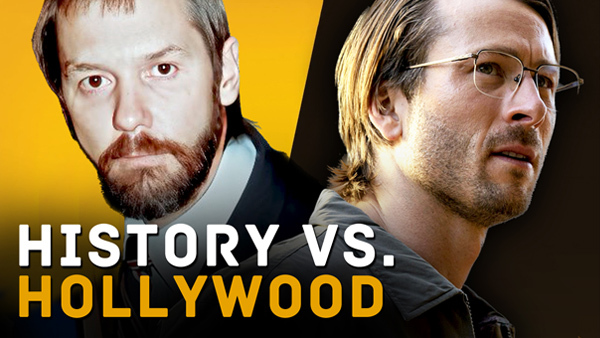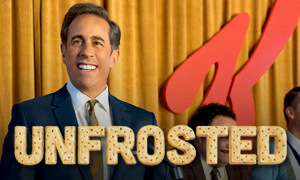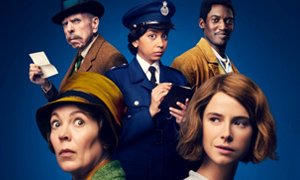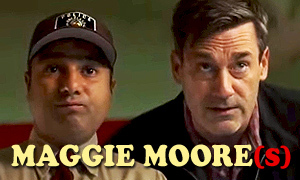Maggie Moore(s): History vs. Hollywood
How closely is Maggie Moore(s) based on a true story?
One thing that makes watching this dark comedy directed by John Slattery a little less disturbing is the fact that the movie is only loosely inspired by a real-life case of two female victims with the same name who were murdered within days of one another. Instead of claiming to be based on a true story or even inspired by one, the opening title card just tells us that "some of this actually happened," leaving the audience to wonder which parts of the film are based in fact. After all, if you do a Google search on the phrase "real Maggie Moores," you'll quickly discover that Maggie Moore is a fictional name created for the film. The two real-life murder victims were Mary Lou Henderson Morris, 48, and Mary McGinnis Morris, 39. Both are pictured below.
It's obvious that the filmmakers changed the names to protect themselves against potential lawsuits brought by the families of the victims, in addition to the fact that the Maggie Moore(s) movie bears little resemblance to the real story. This was a wise decision given that some family members have already expressed outrage that the deaths of their loved ones have become fodder for a comedy (more on what they said later). When Entertainment Weekly reached out to the filmmakers for comment, they distanced themselves from the Mary Morris murders, which remain unsolved, and emphasized that their story is "a fictional one" that was "inspired in part by a real crime." In the following questions, we'll explain just how much of the Maggie Moore(s) movie is indeed fictional.
When did the real Maggie Moore murders take place?
A Maggie Moore(s) fact-check reveals that the real-life murders of the two women, both named Mary Morris, happened within 72 hours of one another in October 2000 in Houston, Texas. The movie's mostly fictional story is set in the present day.
Did the real Maggie Moore murders happen the same way they do in the film?
In the movie, the first Maggie Moore we're introduced to was shot in the back of the head by a hitman. Her body is found in a parking lot after she appears to have either jumped, been pushed, or fallen over a railing. We quickly learn that just days earlier, another woman named Maggie Moore had been burned to a crisp in her car. In real life, the bodies of both women, who shared the name Mary Morris, were found in their cars several days apart. The charred body of the first victim, Mary Lou Morris, had indeed been found in her car, which had been set ablaze just off the road in a remote area outside the city.
"We really don't know how she died," Marilyn Blalock told Houston's FOX 26 of her mother, Mary Lou Morris. "Because unfortunately she was found in her car, and it was burned." Her body had been burned so badly that she was identified by way of a tooth and dental records.
As for Mary McGinnis Morris, she was found in her car approximately three days later and relatively close by. She had been viciously beaten and shot in the head.
Did the real-life Maggie Moore murders happen in a small desert town?
No. In the film, the events unfold in the sparsely-populated fictional location of Buckland County, New Mexico. The Maggie Moore(s) true story reveals that the real-life murders of Mary Lou Morris and Mary McGinnis Morris, the real Maggie Moores, took place in the densely populated Harris County, Texas, which contains most of the city of Houston.
Are Jon Hamm and Tina Fey's characters based on real people?
No. In the Maggie Moore(s) movie, Jon Hamm portrays a small-town police chief named Jordan Sanders and Tina Fey plays Rita Grace, a casino employee who is the neighbor of one of the victims. Chief Sanders lost his wife a year ago and is still trying to figure out how to move forward. Rita got divorced from an ex-husband who crushed her spirit and broke her down. Sanders begins a friendship/budding romance with Rita, who helps him to shed his sullenness, in addition to assisting him with the Maggie Moores murder cases. These two characters are fictional. The real-life Houston detective who investigated the second murder was Detective Wayne Kuhlman. He shares virtually no similarities to John Hamm's character, small-town police chief Jordan Sanders. The chief's sidekick, Deputy Reddy (Nick Mohammed), who cracks jokes at awkward times and becomes overly invested in the chief's love life, is also fictional, as is what happens to him at the end of the movie.
Did the husband of the real Maggie Moore hire a hitman to scare her after she discovered he had been trafficking in child pornography?
No. In the movie, the Maggie Moore played by Louisa Krause discovers that her husband, Jay Moore (Micah Stock), has been giving envelopes filled with child pornography to a shady figure named Tommy T (Derek Basco), who supplies Jay's sandwich shop with expired ingredients at a major discount. Maggie immediately calls it quits with her husband, but Jay is worried that she's going to turn him in to the police. He hires a hitman (Happy Anderson) to scare her, but the "scaring" devolves into a brutal murder when she fights back. Enter local police chief Jordan Sanders and his sidekick Deputy Reddy, who try to piece together what happened.
While there is a hitman theory around the real-life murders, the movie's version of the story is mostly fictional. The two real-life murders of Mary Lou Henderson Morris and Mary McGinnis Morris in October 2000, which inspired the film, remain unsolved. Police believe that the deaths of the two women are a coincidence and that the murders are not connected. However, the daughters of the victims feel that the deaths of their mothers (both named Mary Morris) so close together have to be linked. There is indeed a theory that a hitman mistakenly killed Mary Lou Morris, 48, a loan officer at a Chase Bank in Houston on the morning of October 12, 2000.
Reportedly happily married, Mary Lou's husband tried to call her throughout the day but she never returned his calls. This was unusual for Mary Lou, so around 5 p.m. he phoned her supervisor at the bank. He was informed that she hadn't come into work that morning and she wasn't answering their calls either. At about the same time he was reporting her missing, a man who had been driving down the highway called 911 to report a smoldering car near the road. It wasn't even three miles from the home of Mary Lou and her husband in Baytown. Police discovered that her body had been drenched in gasoline and set ablaze. The fire had destroyed any evidence of how she died. Mary Lou's wedding ring and purse were missing. One theory is that a hitman would have taken the ring as proof she was dead.
Three days later, the case was met with an unusual twist. The body of the similarly-named Mary McGinnis Morris, a 39-year-old nurse practitioner, was found in her car not far from the location where Mary Lou Morris' body had been discovered. She had been viciously beaten and shot in the head. She had made a terrifying 911 call during her attack, which was deemed too disturbing to be made public. Her killer attempted to stage her death as a suicide by placing a gun that had been stored under the driver's seat of her car on the passenger's seat next to her. It was later confirmed that the gun, which was registered to Mary's husband Mike, had been used to shoot her.
While it was hard to find suspects or a motive in the death of the well-liked and happily married first victim, Mary Lou Morris, this wasn't the case with the younger Mary McGinnis Morris. Prior to her death, she had told one of her best friends, Laurie Gemmel, that she was afraid of a newer male nurse at work, a man named Duane Young. She believed that Young was capable of harming her, and she even once found her desk in disarray with pictures facing the wrong direction. On his desk, she noticed the words "death to her" written on a piece of paper and she assumed it was about her. Mary McGinnis suspected Young was behind it and supposedly asked her husband if he could teach her how to use a gun, which was then stored under the driver's seat of her car.
According to Unsolved Mysteries, investigators first focused on Young, who had quit his job after allegedly attempting to discredit Mary McGinnis. Detectives claim they possess evidence linking him to the murder. While Young remains a suspect, Mary McGinnis' husband, Mike Morris, also aroused suspicion. -Unsolved Mysteries
Did the husbands of the victims become suspects?
As indicated in the image above, Mary McGinnis Morris' husband, Mike Morris, was the only husband that drew the attention of police and became a prime suspect. In researching the Maggie Moore(s) true story, we learned that he first refused to meet with investigators without an attorney (he claimed he was following the legal advice of several trusted friends). He then refused to take a polygraph test, claiming he was worried that the anti-anxiety medications and anti-depressants he was on might affect the results. As for an alibi, he said he was at the movies with his daughter at the time of his wife's murder. However, he refused to allow his daughter to be questioned.
As we explored the Maggie Moore(s) fact vs. fiction, we learned that detectives discovered that Mike and his wife Mary were having serious marriage troubles. Mike had heard rumors of an affair between Mary and a family friend. He confronted them both and they denied it, looking him in the eye and telling him "there had been nothing inappropriate in their relationship." Mike says he believed they were telling the truth. -Unsolved Mysteries
With regard to motive, there was also a $700,000 life insurance policy on Mary McGinnis Morris of which Mike Morris was the beneficiary. A significant piece of evidence that raised further suspicion around Mike was a four-minute phone call that he made to Mary's cell phone two hours after she had placed her terrifying call to 911 at the time detectives believe she was murdered. While Mike claimed that no one answered and her phone just kept ringing the whole time, Detective Wayne Kuhlman stated that "this was, by all indications of the cellular telephone company, a completed call." He said that the call showed up on Mary's cell phone bill, which would not have happened if no one answered. "The question is: Who answered the phone on the other end? That's what the big question is. And what did they talk about for the four minutes?"
"I had absolutely nothing to do with the arrangement of Mary's murder," said husband Mike Morris. "It's a hurtful insinuation. It's absolutely untrue." -Unsolved Mysteries
Is there any evidence to support the theory that a hitman murdered both women?
Yes. In between the Mary Morris murders, there was a mysterious phone call allegedly made to a local newspaper in which the caller said that Mary Lou Henderson Morris had been killed by mistake. Mary McGinnis Morris' good friend, Laurie Gemmell, described the call in an episode of Unsolved Mysteries:
A call came in to the Houston Chronicle, and I verified this with somebody at the Chronicle, between the time the first Mary Morris was killed and the time my friend was killed, saying something to the effect that they got the wrong Mary Morris the first time.
Further supporting the hit-gone-wrong theory is the fact that the wedding ring of the first Mary Morris was not found at the crime scene, which is one way a hitman would prove they got the job done. However, detectives don't believe there's any evidence to suggest the first murder was a botched hit. Jay Morris, the husband of the first victim, disagrees:
The astronomical odds that two Mary Morrises were killed three days apart, very similar in looks, to me, that's what it is. Astronomical odds that they're not connected.
What do the families of the two real-life murder victims think of the film?
"It's very distasteful because we're still living with this. These women are staples in our lives. That was my mother," says Marilyn Blalock, 48, the daughter of the late Mary Lou Morris. "Initially, [my reaction to the trailer] was shock. I found it absolutely unbelievable. Because this is the worst thing that's ever happened to me — and then to figure out that it was being done in a comedic format was really hurtful. To know that people are going to be laughing about it is a sickening feeling."
"...I can only view this as a spin-off of the true story," says Katharyn Morris, daughter of the late Mary McGinnis Morris. I only wonder why the actual case has never garnered this much attention." Katharyn feels that the release of the Maggie Moore(s) movie will only put her family in greater danger since the real-life killer was never caught, nor has any motive been found for her mother's death or the death of Mary Lou Morris. In fact, Katharyn says there is a 'person of interest' in her mother's murder who has repeatedly tried to make contact with her over the years. The individual has also contacted other family members, her peers, and employers. -Entertainment Weekly
Did the filmmakers consult with the families of the two victims prior to making the movie?
No. While conducting our Maggie Moore(s) fact-check, we learned that Marilyn Blalock, 48, and Katharyn Morris, 37, the daughters of the two victims, said they didn't find out about the film until the release of the movie trailer in April 2023, approximately two months before the film was released on VOD. In the weeks that followed, they did speak to director John Slattery and producer Vincent Garcia Newman via conference call, who apologized for any disturbing similarities between the movie and their mothers' stories.
"While I can't say that all of my fears were put to rest, I am hopeful that, with their assistance, the real cases that inspired the movie will get the attention they deserve," Katharyn Morris, 37, the daughter of the late Mary McGinnis Morris, told Entertainment Weekly.
Have any other movies, TV series or podcasts been made about the Mary Morris murders?
To our knowledge, no other movies or TV series have been made about the Mary Morris deaths. However, in the 22 years since the tragic events unfolded, the two murders have been the subject of articles and true crime podcasts. The story was also featured in two different episodes of Unsolved Mysteries.
Overall, how accurate is Maggie Moore(s)?
Maggie Moore(s) fictionalizes and convolutes the true story to such a degree that it's a stretch to attempt to draw comparisons between the real-life victims, both named Mary Morris, and the two Maggie Moores in the movie. In the film, Jon Hamm's police chief Jordan Sanders comments to Deputy Reddy (Nick Mohammed), "Was Maggie One mistaken for Maggie Two, or is [the murder of] Maggie Two to cover for Maggie One?" The film lets the audience in on what Sanders and Reddy don't yet know—the murder of the second Maggie was to cover for the murder of the first. With regard to the real-life murders, the opposite theory seems the most valid—Mary Morris One was mistaken for Mary Morris Two.
The film makes things more confusing by taking certain aspects of the real-life murders and applying them to what seems to be the opposite victim in the movie. Therefore, it's hard to draw a direct correlation between the two real-life victims and the victims in the movie. For instance, virtually all of the suspicions, suspects, and motives in real life revolved around the murder of the second Mary Morris, Mary McGinnis Morris. She was reportedly having marriage trouble with her husband, she had felt threatened by a male coworker, she had a $700,000 life insurance policy on her that her husband would benefit from, and her husband's actions after her death aroused suspicions. When it came to the death of the first Mary Morris, Mary Lou Henderson Morris, whose body had been burned up in her car, police found little in her life that would give anyone a reason to kill her. She most resembles the second victim in the movie, but it's hardly a direct match. It would be an injustice to both of the real-life victims to try and claim that either is represented by the heavily fictionalized victims in the movie.
In the end, this is not a film that should be watched in order to gain any sort of insight into the real-life story that very (stress very) loosely inspired it. Jon Hamm's Chief Sanders, Nick Mohammed's Deputy Reddy, the nosey neighbor portrayed by Tina Fey, Happy Anderson's hitman Kosco, and a number of other characters are all fictional. The real-life murders were never solved. There is also no evidence that the death of either victim had anything to do with child pornography. It's not hard to see why the family members of the victims would be disturbed by the film. In addition to putting the deaths of their loved ones at the center of a dark comedy, telling the audience that "some of this actually happened," without pointing out what is fact and what is fiction, will cause many viewers to falsely believe the film's numerous fabrications.







